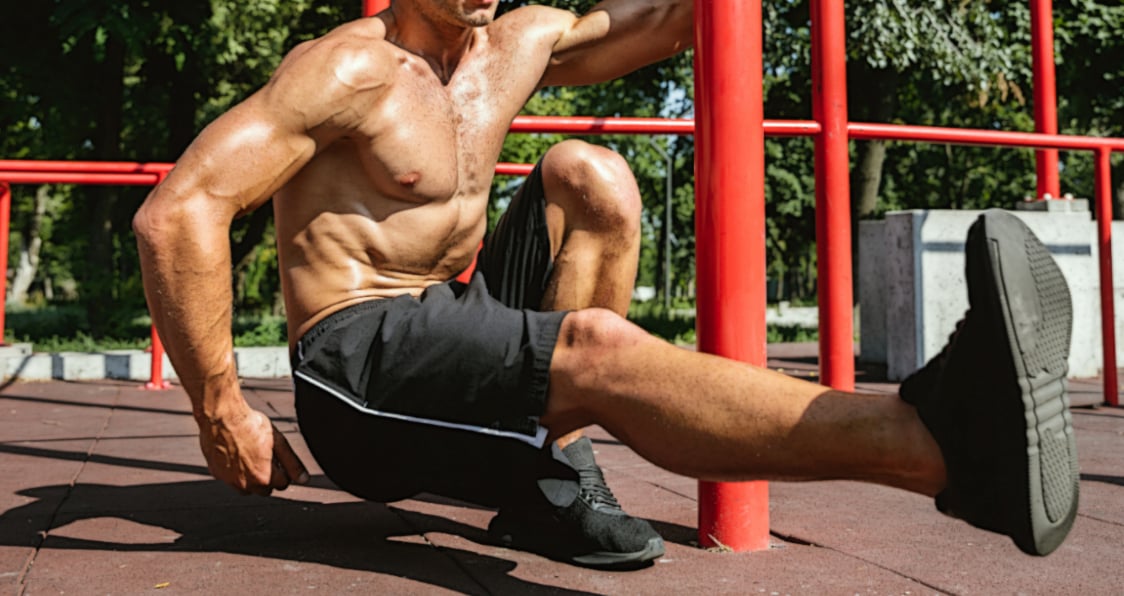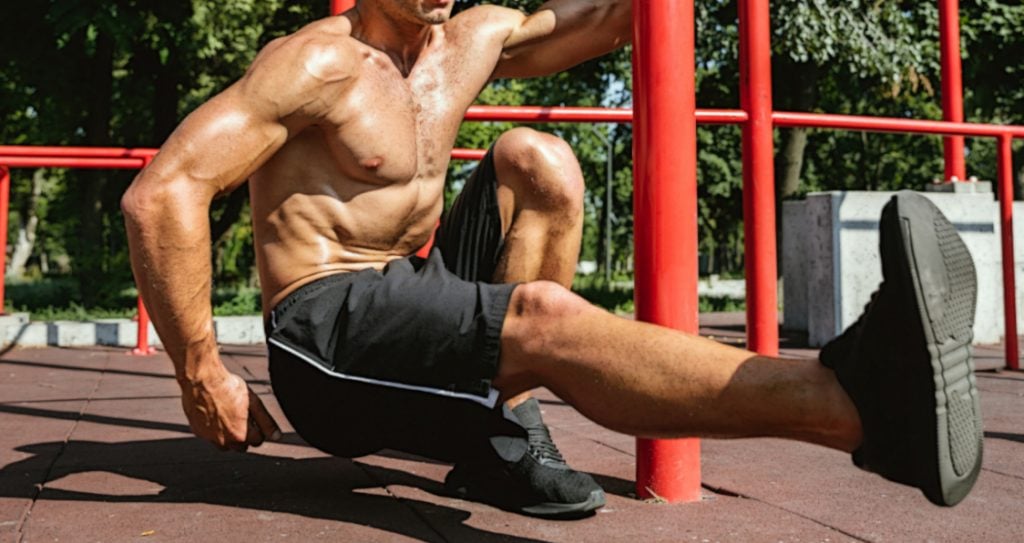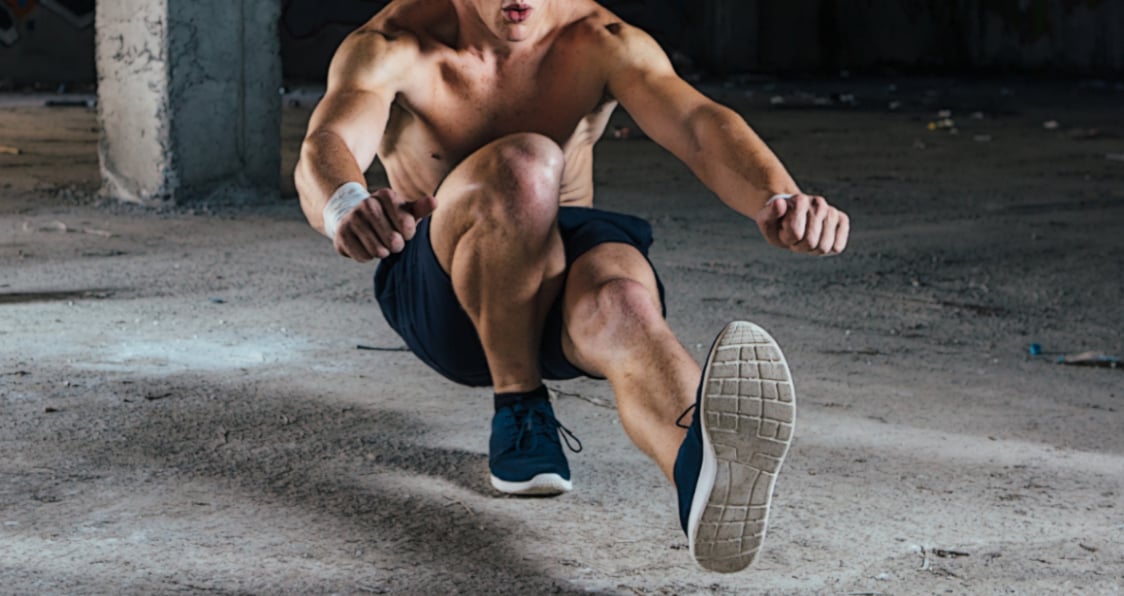Pistol Squat Overview and Coaching Guide
One of the most effective unilateral exercises that can be performed for strengthening the legs, mobilising joints and improving movement mechanics is the pistol squats.
The pistol squat effectively targets the quadriceps, glutes, abdominals, obliques and ankle stabilizers.
This article will review the pistol squats, provide a step by step coaching guide and investigate a number of the associated benefits.
It will conclude by providing a selection of pistol squat variations to help you master the technique and facilitate maximal gains.
Pistol Squat Coaching Points
This first section will detail how to successfully set up and execute a full pistol squats.
1) Start by assuming a one legged stance keeping the foot directly under the hip and the toes pointed straight or slightly turned out.
Contrary to belief, pistol squats are not bad for your knees, providing this stance is assumed. It will ensure that knee stays over the toes as you squat which will prevent shearing forces from acting on the knee.
2) Keeping the opposing leg straight, drive the chest up and squeeze the core muscles tightly before flexing at the knee.
Look to counterbalance by extending the arms out in front of the body. This will facilitate control and balance throughout the movement.
3) Keeping the weight equally distributed through the foot, gradually drop into a full squat. While you lower, ensure that you lean forward slightly with the trunk (as you would in a back squat).
A common issue experienced as the body drops is that the heel gradually lifts off the floor.
This occurs for typically one of two reasons. Either the ankles are not mobile enough or the hips are not being pushed back far enough.
Lifting of the ankle during a pistol squat is not recommended as it can apply excessive force to connective tissues and consequently cause injury.
4) Avoid bouncing up and out of the squat and instead keep the movement controlled. Aggressively bouncing up is not recommended unless you are highly conditioned.
Those who aggressively rebound out of the squat may develop ankle and knee issues. Bouncing tends to cause a reduction in coordination, muscle recruitment and stability thus enhancing injury risk.
5) After controlling the descent, powerfully engage the muscles of the legs to drive the body back up to the starting position. Once again, ensure that the core remains tight throughout.
6) Assume a stable and fully supported upright position on the working leg. Repeat this process for the desired number of reps.
Ensure that you are truly stable before completing the next rep. Rushing through reps may compromise joint positions and movement efficiency.
Benefits of the Pistol Squat
As stated earlier, there are a vast number of benefits related to performing the pistol squats regularly.
1) Unilateral Strengthening
Unilateral simply refers to using a single limb as opposed to bilateral which is the use of both limbs.
Daily movements, exercise and injury can all contribute toward imbalances. The benefit of performing unilateral movements is that these imbalances can level out (1).
Reducing imbalances can have a positive impact on strength capabilities, movement and injury risk.
In addition, the pistol squats can help to improve performance with other squatting exercises, such as the back or front squat.
2) Improved Proprioception
The pistol squat is superb for developing the body’s understanding and control over movement – also known as proprioception.
More specifically the exercise can enhance coordination and balance which can directly impact performance and injury risk (2).
3) Joint Health
Performing pistol squats in a controlled fashion can reinforce efficient movement patterns and range of motion thus improving overall joint health.
Avoid the temptation to perform fast-paced and erratic pistol squats which will more than likely lead to an overuse injury.
4) Muscle Activation
It has been documented that unilateral squats can activate muscles to a greater degree than bilateral squats (3).
Increasing muscle recruitment and activation can accelerate the rate of strength and movement improvements.
5) Athletic Performance
Many sports require a large degree of single leg strength and stability. Therefore, the pistol squats can be highly advantageous for sportspeople and athletes.
The exercise is a foundational bodyweight movement that should form part of most athlete’s training.
Additionally, using a number of the following pistol squat variations can have a substantial positive impact on athletic performance.
Pistol Squat Variations

For those who are struggling to complete the pistol squat, firstly look to improve your mobility – specifically around the ankles (4).
From there, look to use a selection of the following pistol squat variations before advancing onto a full pistol squat.
1) Deep Bodyweight Squat
The bilateral bodyweight squat is one of the most influential movements for improving leg strength, joint mobility and proprioception.
When performing this exercise, look to drop as deeply as possible while maintaining solid form.
2) Rocking Pistol
Sit on a box with one foot flat on the floor. Lean back and then rock forward using momentum to assist you as you drive up to standing.
3) Box Pistol
This is a progression of the rocking pistol. This time, avoid using momentum and fully focus on contracting leg muscles to lift the body from the box.
4) Elevated Pistol
Stand on a box or a step and let the other leg hang out to the side before dropping into the pistol. This method can effectively enhance balance, range of motion and eccentric strength.
5) Assisted Pistol
Holding onto bands or straps during a pistol squats can improve balance and simplify the movement. Add in an isometric hold at the bottom of the squat to increase difficulty.
6) Rolling Pistol
For this dynamic regression, start by lying on your back. Rock the body backwards and then roll forward aggressively, plant the foot and immediately drive up into the squat.
Final Word
The pistol squat is an advanced bodyweight exercise which demands a great degree of mobility, strength, balance and coordination.
If you are new to the pistol squats, be prepared to spend time on learning and mastering the technique. Using a number of aforementioned variations can help to accelerate technique improvements.
For more news and updates, follow Generation Iron on Facebook, Twitter, and Instagram.
References:
1-Gonzalo-Skok, Oliver; Tous-Fajardo, Julio; Suarez-Arrones, Luis; Arjol-Serrano, José Luis; Casajús, José Antonio; Mendez-Villanueva, Alberto (2017-1). “Single-Leg Power Output and Between-Limbs Imbalances in Team-Sport Players: Unilateral Versus Bilateral Combined Resistance Training”. International Journal of Sports Physiology and Performance. 12 (1): 106–114. doi:10.1123/ijspp.2015-0743. ISSN 1555-0273. PMID 27140680.
2-Riva, Dario; Bianchi, Roberto; Rocca, Flavio; Mamo, Carlo (2016-2). “Proprioceptive Training and Injury Prevention in a Professional Men’s Basketball Team: A Six-Year Prospective Study”. Journal of Strength and Conditioning Research. 30 (2): 461–475. doi:10.1519/JSC.0000000000001097. ISSN 1064-8011. PMC 4750505. PMID 26203850.
3-McCurdy, Kevin; O’Kelley, Erin; Kutz, Matt; Langford, George; Ernest, James; Torres, Marcos (2010-2). “Comparison of lower extremity EMG between the 2-leg squat and modified single-leg squat in female athletes”. Journal of Sport Rehabilitation. 19 (1): 57–70. ISSN 1056-6716. PMID 20231745.
4-Kim, Si-Hyun; Kwon, Oh-Yun; Park, Kyue-Nam; Jeon, In-Cheol; Weon, Jong-Hyuck (April 7, 2015). “Lower Extremity Strength and the Range of Motion in Relation to Squat Depth”. Journal of Human Kinetics. 45: 59–69. doi:10.1515/hukin-2015-0007. ISSN 1640-5544. PMC 4415844. PMID 25964810.









